2015 AUDI S3 SEDAN tire pressure
[x] Cancel search: tire pressurePage 220 of 282
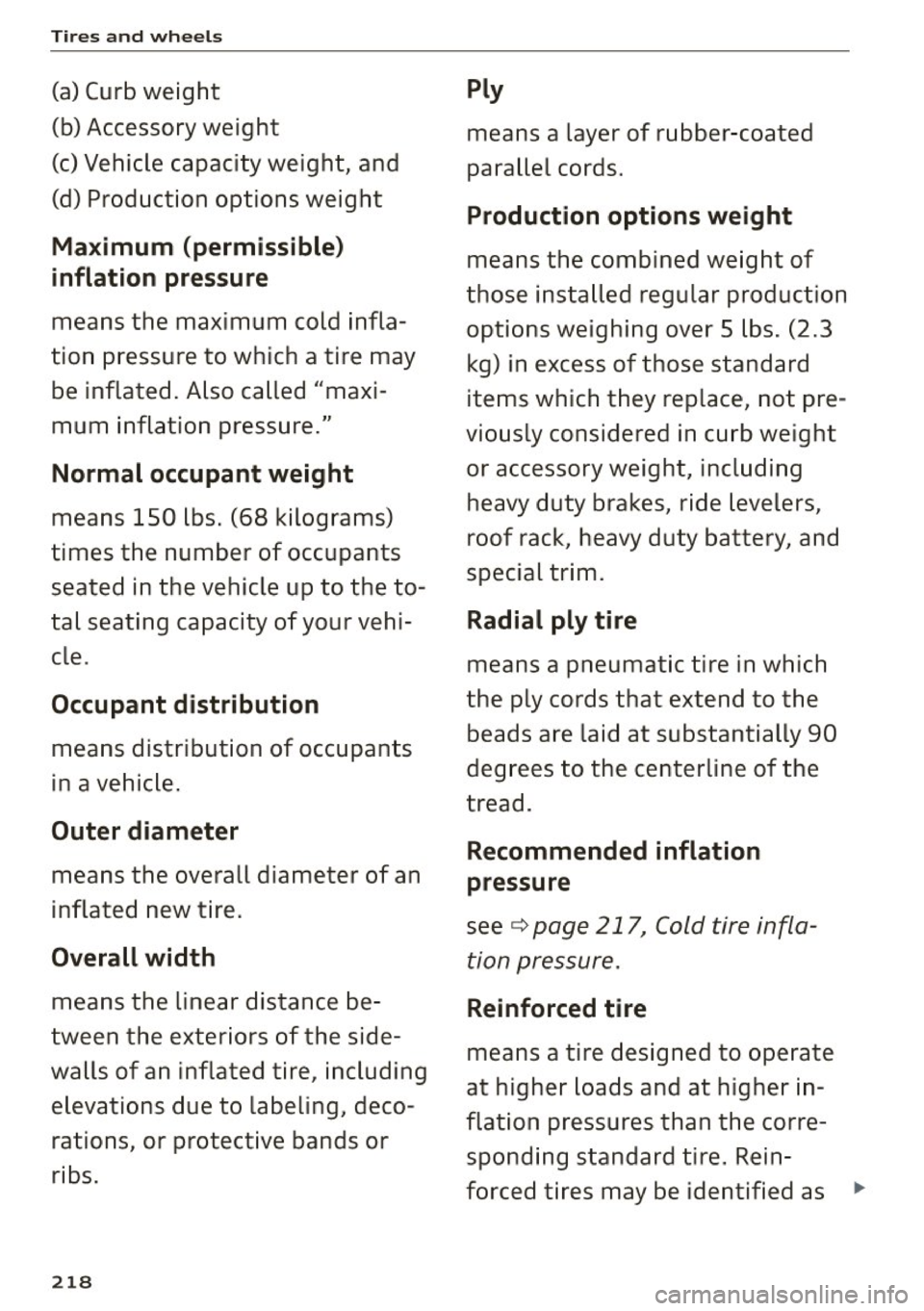
Tires and wheels
(a) Curb weight
(b) Accessory weight
(c) Vehicle capacity weight, and
(d) Production options weight
Ma ximum (permissible )
inflation pres su re
means the max imum cold infla
tion pressure to which a tire may be inflated. Also called "maxi
mum inflation pressure."
Normal occupant weight
means 150 lbs. (68 kilograms)
times the number of occupants
seated in the vehicle up to the to
tal seating capacity of your vehi
cle .
Occupant d istribution
means distribution of occupan ts
in a vehicle .
Outer diameter
means the overall diameter of an
inflated new tire.
Overall width
means the l inear distance be
tween the exteriors of the side
walls of an infla ted tire, including
elevations due to labeling , deco
rations, or protective bands or
ribs.
2 18
Ply
means a layer of rubber -coated
parallel cords.
Production options weight
means the comb ined weight of
those installed regular production
options weighing over 5 lbs. (2.3 kg) in excess of those standard
items which they rep lace, not pre
viously considered in cu rb weight
or accessory weight, including heavy duty brakes, ride levelers,
roof rack, heavy duty battery, and
special trim.
Radial ply tire
means a pneumatic tire in which
the ply co rds that extend to the
beads are laid at substantially 90
deg rees to the centerline of the
tread.
Recommended inflation
pressure
see ~ page 217 , Cold tire infla
tion pressure.
Reinforced tire
means a tire designed to operate
at higher loads and at higher in
flation pressures than the corre sponding standard tire. Rein
forced tires may be identified as
Page 221 of 282
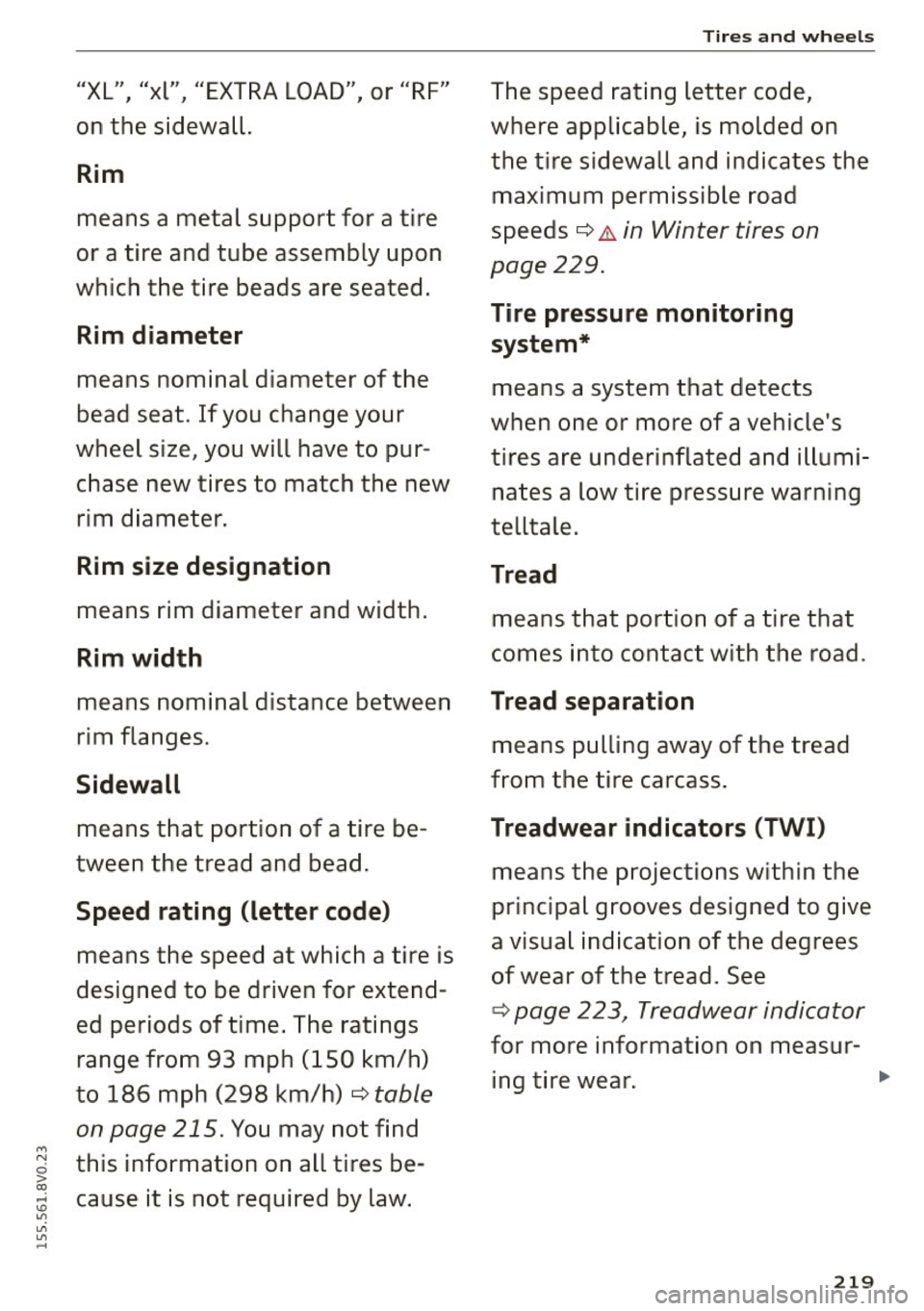
"XL" "xl" "EXTRA LOAD" or "RF" , , ,
on the sidewall.
Rim
means a metal support for a tire
or a tire and tube assembly upon
which the tire beads are seated.
Rim di ameter
means nominal diameter of the
bead seat. If you change your
wheel size, you will have to pur
chase new tires to match the new rim diameter .
Rim size de signation
means rim diameter and width.
Rim width
means nominal distance between
rim flanges.
Side wall
means that portion of a tire be
tween the tread and bead.
Speed rating (letter code )
means the speed at which a t ire is
designed to be driven for extend
ed periods of time . The ratings
range from 93 mph ( 150 km/h)
to 186 mph (298 km/h)¢
table
on page 215.
You may not find
this information on all tires be
cause it is not required by law .
Tires and wheels
The speed rating letter code,
where applicable, is molded on
the tire sidewall and indicates the
maximum permissible road
speeds
¢ .& in Winter tires on
page 229 .
Tire pressure mon itoring
system *
means a system that detects
when one or more of a vehicle's
tires are underinflated and illumi
nates a low tire pressure warning
telltale .
Tread
means that portion of a tire that
comes into contact with the road .
Tread separation
means pulling away of the tread
from the tire carcass .
Treadwear indicators (TWI )
means the projections w ithin the
principal grooves designed to give
a visual indication of the degrees of wear of the tread. See
¢ page 223, Treadwear indicator
for more information on measur
ing tire wear .
219
...
Page 223 of 282
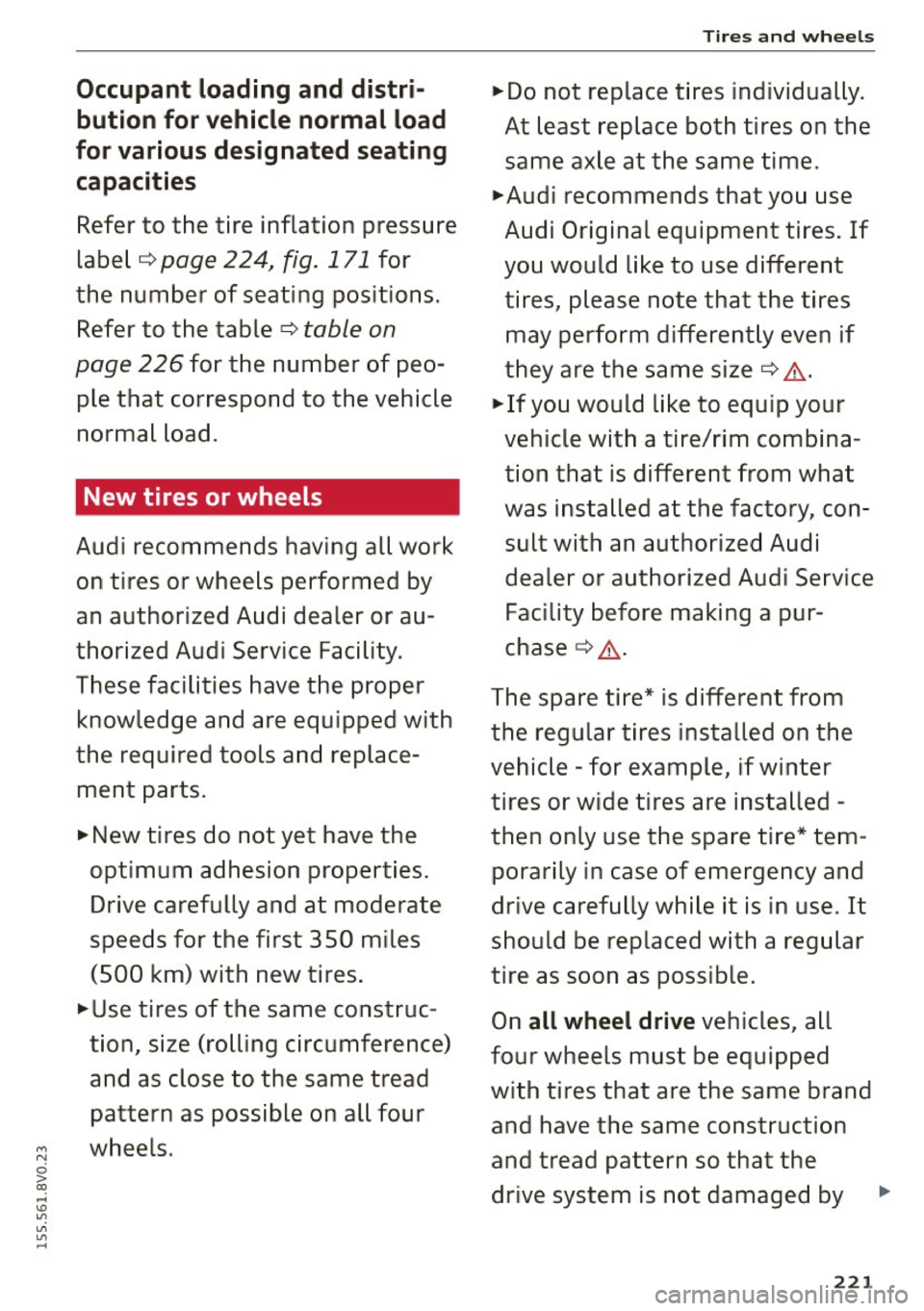
Occupant loading and distri
bution for vehicle normal load
for various designated seating
capacities
Refer to the tire inflation pressure
labe l
c:::> page 224, fig. 171 for
the number of seating positions .
Refer to the table
c:::> table on
page 226
for the number of peo
ple that correspond to the vehicle
normal load.
New tires or wheels
Audi recommends having all work on tires or wheels performed by
an authorized Audi dea ler or au
thorized Audi Service Facility.
These facilities have the proper knowledge and are equ ipped with
the required tools and replace
ment parts .
.,,. New tires do not yet have the
opt imum adhesion properties .
Drive carefully and at moderate
speeds for the first 350 m iles
(500 km) with new tires .
.,,. Use tires of the same construc
tion, size (rolling circumference)
and as close to the same tread pattern as possible on all four
wheels .
Tires a nd whe els
.,,. Do not replace tires individually.
At least replace both tires on the same axle at the same time .
.,,. Audi recommends that you use
Audi Original equipment tires. If
you would like to use different
tires, please note that the tires
may perform different ly even if
they are the same size
c:::> ,& .
.,,. If you would like to equip your
vehicle with a tire/rim combina
tion that is different from what
was installed at the factory, con sult with an authorized Audi
dealer or authorized Audi Service
Facility before making a pur
chase
c:::> ..1,. .
The spare tire* is different from
the regular tires installed on the
vehicle -for example, if winter
tires or wide tires are installed -
then only use the spare tire* tem
porarily in case of emergency and
drive carefully while it is in use. It
should be replaced with a regular
tire as soon as possible.
On
all wheel d riv e vehicles, all
four wheels must be equipped
with tires that are the same brand
and have the same construction
and tread pattern so that the drive system is not damaged by
22 1
Page 224 of 282
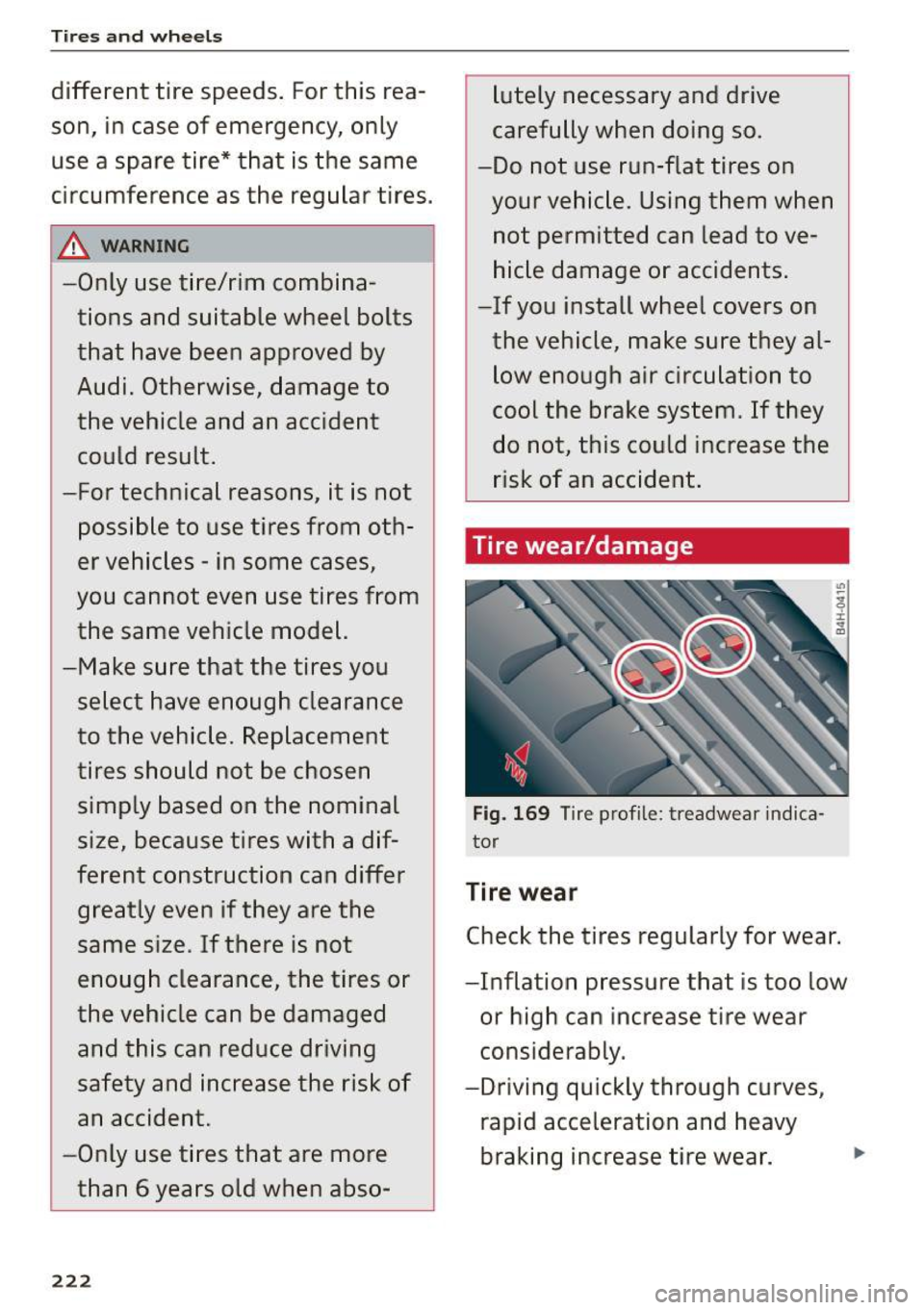
Tires and wheels
different tire speeds. For this rea
son, in case of emergency, only
use a spare tire* that is the same
circumference as the regular tires.
.&,. WARNING -
-Only use tire/rim combina
tions and suitable wheel bolts
that have been approved by
Audi. Otherwise, damage to
the vehicle and an accident could result.
-For technical reasons, it is not
possible to use tires from oth
er vehicles - in some cases,
you cannot even use tires from
the same vehicle model.
-Make sure that the tires you select have enough clearance
to the vehicle. Replacement
tires should not be chosen
simply based on the nominal size, because tires with a dif
ferent construction can differ greatly even if they are the
same size . If there is not
enough clearance, the tires or
the vehicle can be damaged
and this can reduce driving
safety and increase the risk of
an accident.
-Only use tires that are more
than 6 years old when abso-
222
lutely necessary and drive
carefully when doing so.
-Do not use run-flat tires on
your vehicle. Using them when not permitted can lead to ve
hicle damage or accidents.
-If you install wheel covers on
the vehicle, make sure they al
low enough air circulation to
cool the brake system. If they
do not, this could increase the
risk of an accident.
Tire wear/damage
Fig. 169 Tire profil e: treadwear indica
tor
Tire wear
Check the tires regularly for wear.
-Inflation pressure that is too low
or high can increase tire wear
considerably.
-Driving quickly through curves, rapid acceleration and heavy
braking increase tire wear.
..
Page 226 of 282
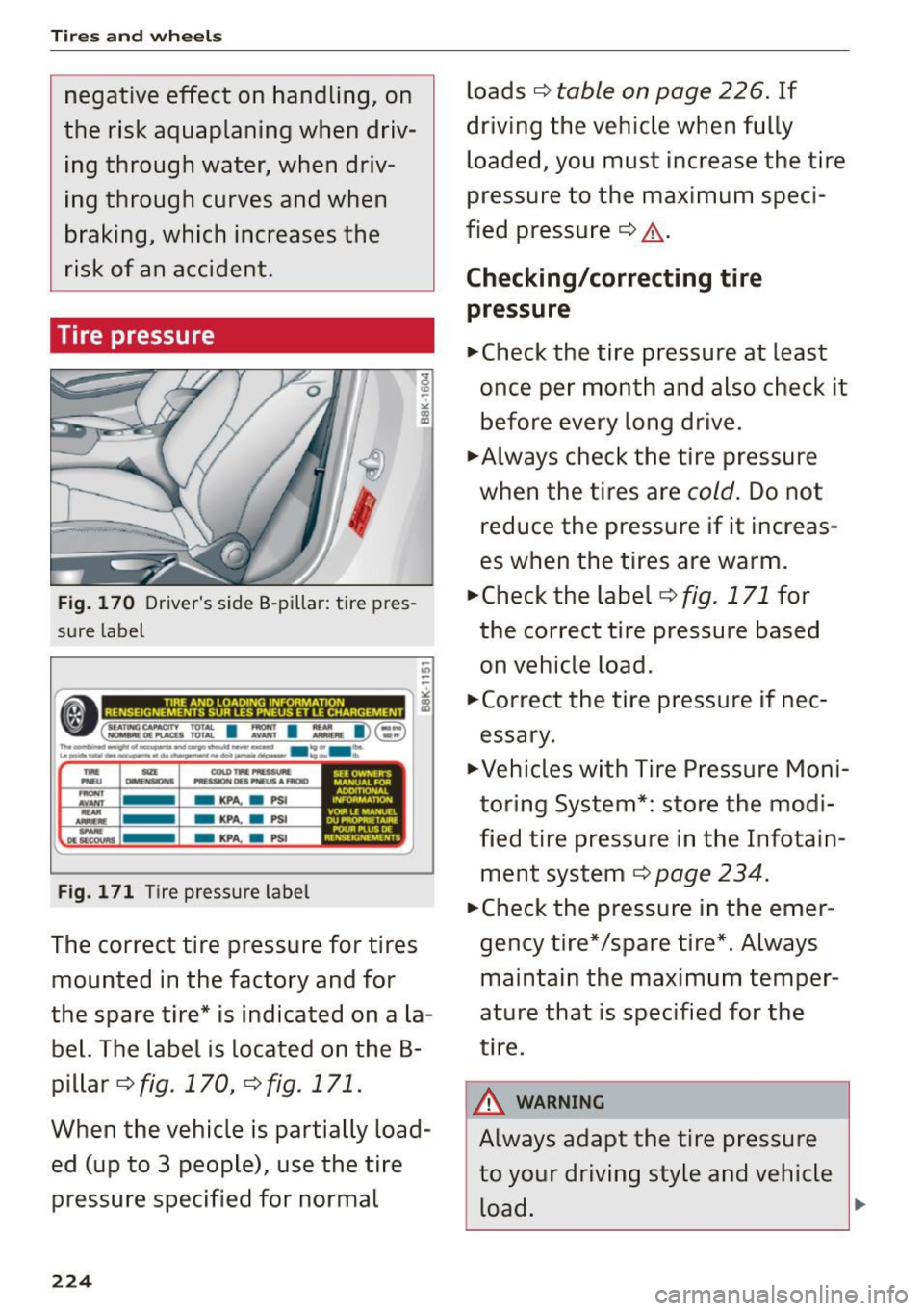
Tires and wheels
negative effect on handling, on
the risk aquaplaning when driv ing through water, when driv
ing through curves and when
braking, which increases the
risk of an accident.
Tire pressure
Fig. 170 Driver's side B-pillar: tire pres
sure label
"' -
( fa (_,__,., TOl... I """" I ~- I)~-~ l ~ • .......-OIJI\ACl'..I TOTAL ltNAHt --.,-. . ~
-KPA. a PSl
Fig. 171 Tire pressure label
The correct tire pressure for tires
mounted in the factory and for
the spare tire* is indicated on a la bel. The label is located on the B
pillar
¢fig. 170, r=:>fig. 171.
When the vehicle is partially loaded (up to 3 people), use the tire pressure specified for normal
224
loads c:> table on page 226. If
driving the vehicle when fully loaded, you must increase the tire
pressure to the maximum speci
fied pressure ¢&, .
Checking/correcting tire
pressure
•Check the tire pressure at least
once per month and also check it before every long drive.
•Always check the tire pressure
when the tires are
cold. Do not
reduce the pressure if it increas
es when the tires are warm.
•Check the label ¢
fig. 171 for
the correct tire pressure based
on vehicle load.
•Correct the tire pressure if nec
essary .
•Vehicles with Tire Pressure Moni
toring System*: store the modi
fied tire pressure in the Infotain
ment system ¢
page 234.
•Check the pressure in the emer
gency tire*/spare tire*. Always
maintain the maximum temper
ature that is specified for the
tire.
A WARNING
Always adapt the tire pressure
to your driving style and vehicle load. .,.
Page 227 of 282
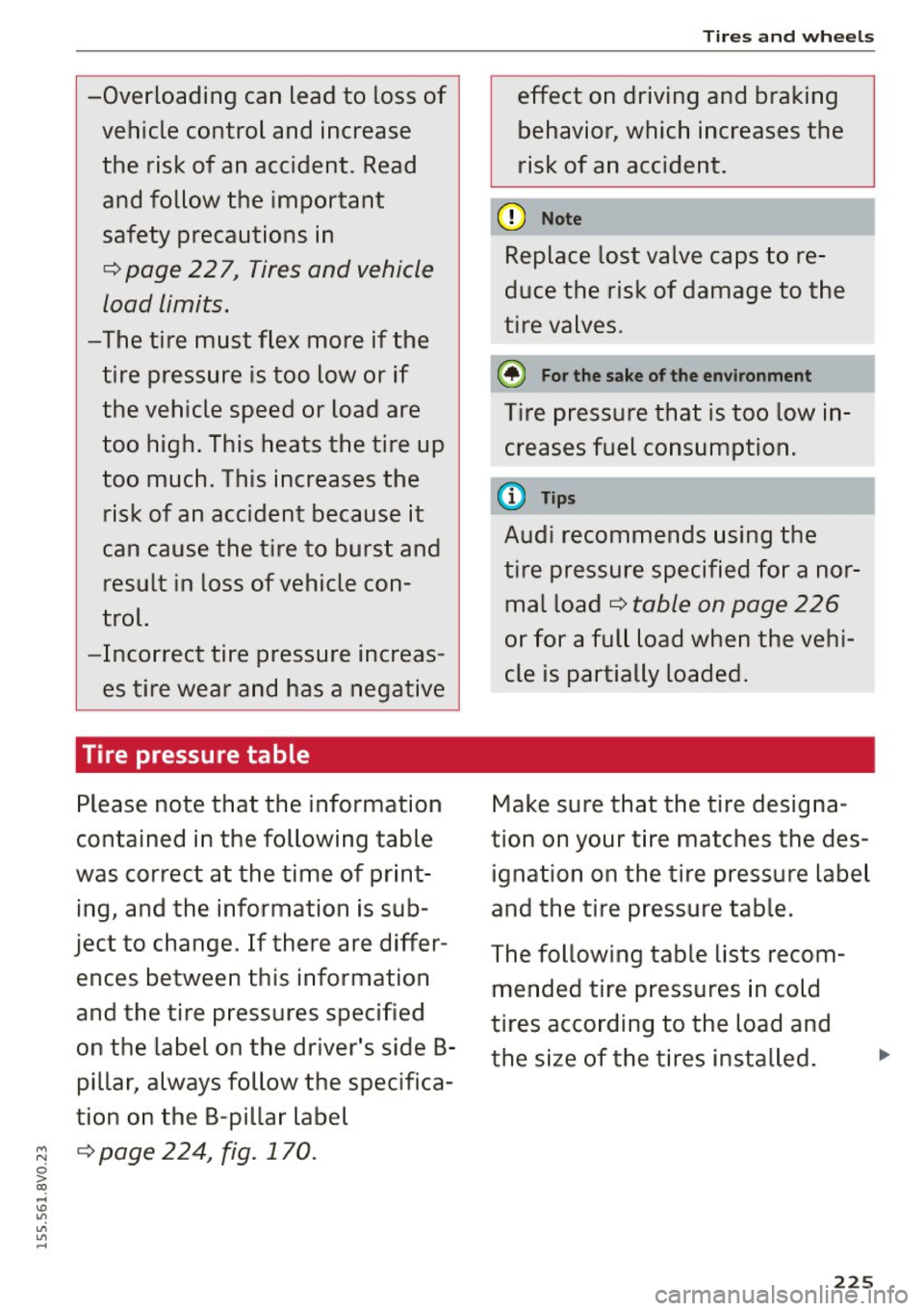
-Overloading can lead to loss of
vehicle control and increase the risk of an accident. Read
and follow the important
safety precautions in
¢ page 22 7, Tires and vehicle
load limits.
-The tire must flex more if the
tire pressure is too low or if the vehicle speed or load are
too high. This heats the tire up
too much. This increases the risk of an accident because it
can cause the tire to burst and result in loss of vehicle con
trol.
-Incorrect tire pressure increas
es tire wear and has a negative
Tire pressure table
Please note that the information
contained in the following table
was correct at the time of print ing, and the information is sub
ject to change. If there are differ ences between this information
and the tire pressures specified on the label on the driver's side B
pillar, always follow the specifica
tion on the B-pillar label
¢ page 224, fig. 170.
Tires and wheels
effect on driving and braking
behavior, which increases the
risk of an accident.
Replace lost valve caps to re
duce the risk of damage to the
tire valves .
@ For the sake of the environment
Tire pressure that is too low in
creases fuel consumption.
(1) Tips
Audi recommends using the
tire pressure specified for a normal load
¢ table on page 226
or for a full load when the vehi
cle is partially loaded.
Make sure that the tire designa
tion on your tire matches the des ignation on the tire pressure label
and the tire pressure table .
The following table lists recom mended tire pressures in cold
tires according to the load and
the size of the tires installed.
225
Page 228 of 282
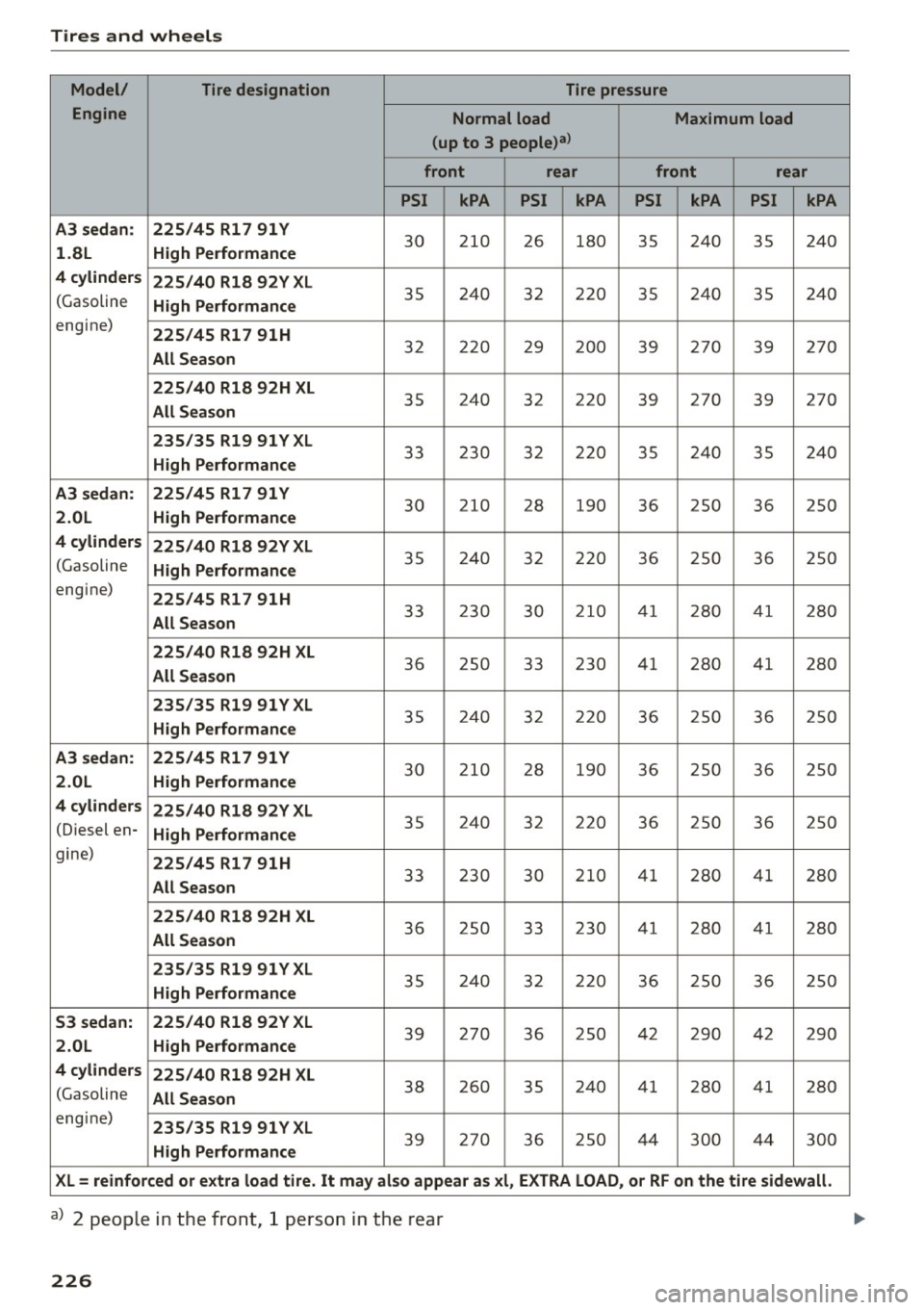
Tires and wheels
Model/ Tire designation Tire pressure
Engine Normal load Maximum load
(up to
3 people)a>
front rear front rear
PSI kPA
PSI kPA PSI kPA PSI kPA
A3 sedan: 225/45 Rl 7 91 Y
30 210 26 1 80 3 5 2
4 0
35 2
4 0
l.BL High Performance
4 cylinders 225/40 Rl8 92Y XL
35 240 32 220 35 240 35 240
(Ga so lin e
High Performance
en gine )
225/45 Rl7 91H
32 220 29 200 39 270 39 270
All Season
225/40 Rl8 92H XL
35 2
40
32 22 0 39 27
0
39 2
70
All Season
235/35 Rl9 91 Y XL 33 230 32 220 35 240 35 240
High Performance
A3 sedan: 225/45 Rl7 91Y
30 21
0 28 190
36 2
50
36 2
50
2.0L High Performance
4 cylinders 225/40 Rl8 92Y XL
35 240
32 220 36 250 36 2 50
(G asolin e
High Performance
e n gine)
225/45 Rl 7 91H
33 230 30 210 41 280 41 280
All Season
225/40 R18 92H XL
36 250 33 2 30 41 28 0 4
1
28 0
All Season
235/35 Rl9 91YXL
35 240 32 220 36 250 36 250
High Performance
A3 sedan: 225/45 Rl7 91Y
30 210 28 190
36 2
50 3 6 250
2.0L High Performance
4 cylinders 225/40 Rl8 92Y XL
35 24
0
32 22 0 36 250 36 250
(D ie se l en -
High Performance
gi ne)
225/45 Rl 7 91H
33 230 30 210 41 280 41 280
All Season
225/40 Rl8 92H XL
36 25
0
33 23
0 41 2 80 41 2 80
All Season
235/35 Rl9 91 Y XL
35 240 32 220 36 250 36 250
High Performance
53 sedan: 225/40 Rl8 92Y XL
39 270 36 250 42 290 42 290
2.0L High Performance
4 cylinders 225/40 Rl8 92H XL
38 260 35 24
0 4 1
28 0 4
1
280
(G asolin e
All Season
e n gine)
235/35 Rl9 91YXL
39 270 36 250 44 300 44 300
High Performance
XL= reinforced or extra load tire. It may also appear as xl, EXTRA LOAD, or RF on the tire sidewall.
a) 2 people in the front, 1 person in the rear
226
Page 229 of 282

.&_ WARNING
Please note the important safe
ty precautions regarding tire pressure ¢
page 224 and load
limits¢
page 227.
Tires and vehicle load limits
There are limits to the amount of load or weight that any vehicle
and any tire can carry . A vehicle
that is overloaded will not handle
well and is more difficult to stop .
Overloading can not only lead to
loss of vehicle control, but can al
so damage important parts of the
vehicle and can lead to sudden
tire failure, including a blowout
and sudden deflation that can
cause the vehicle to crash.
Your safety and that of your pas
sengers also depends on making
sure that load limits are not ex ceeded. Vehicle load includes ev
erybody and everything in and on
the vehicle. These load limits are
technically referred to as the vehi cle's
Gro ss Vehicle We ight Rating
("GVWR").
The "GVWR" includes the weight of the basic vehicle, all factory in
stalled accessories, a full tank of
fuel, oil, coolant and other fluids
Tires and wheels
plus maximum load . The maxi
mum load includes the number of
passengers that the vehicle is in
tended to carry ("seating capac i
ty") with an assumed weight of
150 lbs . (68 kg) for each passen
ger at a designated seating posi
tion and the total weight of any luggage in the vehicle . If you tow
a trailer, the weight of the trailer
hitch and the tongue weight of
the loaded trailer must be includ ed as part of the vehicle load.
The
Gross Ax le Weight Rating
("GAWR") is the maximum load
that can be applied at each of the
vehicle's two ax les.
T he fact that there is an upper
limit to your vehicle's Gross Vehi
cle Weight Rating means that the
total weight of whatever is being
carried in the vehic le (inc luding
the weight of a trai ler hitch and
the tongue weight of the loaded
trailer) is limited. The more pas
sengers in the vehicle or passen
gers who are heavier than the
standard we ights assumed mean
that less weight can be carried as luggage.
The Gross Vehicle Weight Rating
and the Gross Axle Weight Rating .,..
227